From bridges and stadiums to books and the words we hear every day, the ancient Romans have left their mark on our world.
Even thousands of years later, we can still see their influence in architecture, technology, literature, language, and law.
Art and Architecture
The Romans were heavily influenced by ancient Greece. However, they were able to make improvements to certain designs and inventions borrowed from the Greeks. For example, they continued the use of columns, but more as a decoration in Roman buildings. Ancient Romans created curved roofs and large arches. These were able to support more weight than Greek buildings, which used posts and beams. These arches served as the foundation for the massive bridges and aqueducts the Romans created. The game-loving Romans also built large amphitheaters, including the Colosseum. The sports stadiums we see today, with their oval shapes and tiered levels of seating, come from the basic idea the Romans developed.
The arches of the Colosseum are made out of cement, a remarkably strong building material. The Romans made it with what they could easily find: ash and rock from nearby volcanoes. Modern scientists believe that the use of this ash is the reason that structures like the Colosseum still stand today.
Roman underwater structures have proved to be even sturdier. Seawater reacting with the volcanic ash created crystals that filled in the cracks in the concrete. To make a concrete this durable, modern builders must strengthen it with steel. So today, scientists study Roman concrete, hoping to match the success of the ancient master builders.
Sculptural art of the period has proven to be durable too. Romans used marble to make monuments to great human achievements and achievers. You can still see thousands of Roman statues and artifacts in museums worldwide.
Technology and Science
Ancient Romans established tools and methods that have shaped how we approach science and technology.
The Romans were extremely skilled engineers. They understood the laws of physics well enough to develop aqueducts. This was a type of citywide plumbing system that brought in water from outside the city. They harnessed water as energy for powering mines and mills. Romans also built an expansive road network, a great achievement at that time. Their roads were built by laying gravel and then paving the roads with rock slabs. The Roman road system was so large, it was said that "all roads lead to Rome."
The Romans also developed tools and methods for use in agriculture. The Romans became successful farmers due to their knowledge of climate, soil and other planting-related subjects. They developed or refined ways to effectively plant crops and to irrigate and drain fields. Modern farmers still use Roman methods like rotating crops on soil, using manure, and pruning—removing certain branches or leaves to make a plant grow better. The Romans also used mills to process their grains from farming. This improved their efficiency and gave jobs to many people.
Literature and Language
Much world literature has been influenced by writing of the ancient Romans. Poets such as Virgil, Horace, and Ovid produced works that would have an everlasting impact.
Ovid's Metamorphoses, for example, inspired authors such as Geoffrey Chaucer, Dante, and William Shakespeare. Shakespeare, in particular, was fascinated by the ancient Romans.
It is also important to note the huge effect that the Roman language has had on the Western world, meaning Europe and the Americas.
Ancient Romans spoke Latin. This language spread throughout the world as the Roman Empire took over many new lands. Latin became the basis for a group of languages referred to as the "Romance languages." These include French, Spanish, Italian, Portuguese, Romanian, and Catalan. Many Latin root words are also the foundation for many English words. The English alphabet is based on the Latin alphabet. Along with that, much Latin is still used in the present-day justice system.
Law
The use of Latin words is not the only way the ancient Romans have influenced the Western justice system.
The Roman justice system served as a rough outline of how court proceedings happen today.
For example, there was an initial hearing, much like there is today. This is where the magistrate, a kind of government official, decided whether or not there was actually a case. If there were grounds for a case, a prominent Roman citizen would try the case. Witnesses and evidence would be presented. Roman laws and their court system have served as the foundation for many countries' justice systems. The United States and much of Europe are examples.
The ancient Romans helped lay the groundwork for many aspects of the modern world. It is no surprise that a once-booming empire was able to change the world in so many ways.

